For many of us, price is one of the most crucial factors shaping the decision to buy—or invest—in software development. Before you pen a list of features that will make your audience roar, you will likely want to know, how much does it cost to build an app?
But here’s the thing: a quick Google search gives rather vague answers like, “it depends” or wide ranges no one can navigate without a map. Thus, based on the complexity of the app’s design, the average announced custom app development cost is as follows.
| Type | Cost (for 1 platform) | Example |
|---|---|---|
| Simple app | $45K–$150K | Restaurant menu app, online catalog app |
| Medium-complexity app | $150K–$300K | McDonald’s loyalty app, Wikipedia app |
| Complex multi-featured app | $300K–$500K | Uber, Instagram, eBay |
Can you skip paying the price of custom mobile app development and go with a web version instead? According to stats, an average user spends almost 5 hours per day on their mobile device–92.5% of which is on mobile apps, and the remaining 7.5% goes to web browsers.
The number of inquiries regarding how to develop an app keeps growing. Among the main reasons for mobile apps growing in popularity over web versions are:
- Better personalization due to the use of GPS, push notifications, and access to usage history
- Ability to work with a poor internet connection or offline
- Easier navigation due to gestures
- Faster performance since the data is stored locally
You can attempt to estimate which category described in the table above is your intended app, or read on to learn the factors constituting the mobile app development cost, why real costs may go over the initial estimate, and tips for keeping expenses within the planned budget.
Syndicode expertise in custom mobile app development
We have been providing full-cycle mobile app development services since 2014. Syndicode engineers know how to develop an app, both native and cross-platform, and PWAs. Our clients benefit from our specialized knowledge, growing their customer base and increasing profits.
Among our recent projects, there is Le New Black. This marketplace needed an upgrade to meet current functional requirements. This is a B2B platform that connects fashion businesses with retailers. Their mobile application didn’t provide a convenient search option, the vast assortment and the size of catalogs made the order-forming process complicated, and the application’s overall performance was subpar. Additionally, the client wanted a way to enable information extraction from a user’s payment card instead of manual input to simplify the checkout process.
The Syndicode team has designed and developed a new UX-centered search and navigation system to simplify the in-app activity. We implemented a live search feature that decreased the number of actions the user had to perform to reach their goal. Our custom Collection View-like control enables users to filter their search by a wide range of criteria without any shrinkage in performance or UX, as it happens when using standard iOS controls.
Next, our engineers implemented an automated video playback feature that allowed video integration from various sources, including YouTube. Normally, YouTube doesn’t allow direct video integration at the code level, only allowing playback in a browser. Syndicode has solved this problem.
Finally, Syndicode developers wrote an image processing module from scratch based on the OpenCV and Google Cloud Natural Language technologies. Despite being feature-rich and working with massive loads of data, the Le New Black app is lightweight and compatible with older iOS versions.
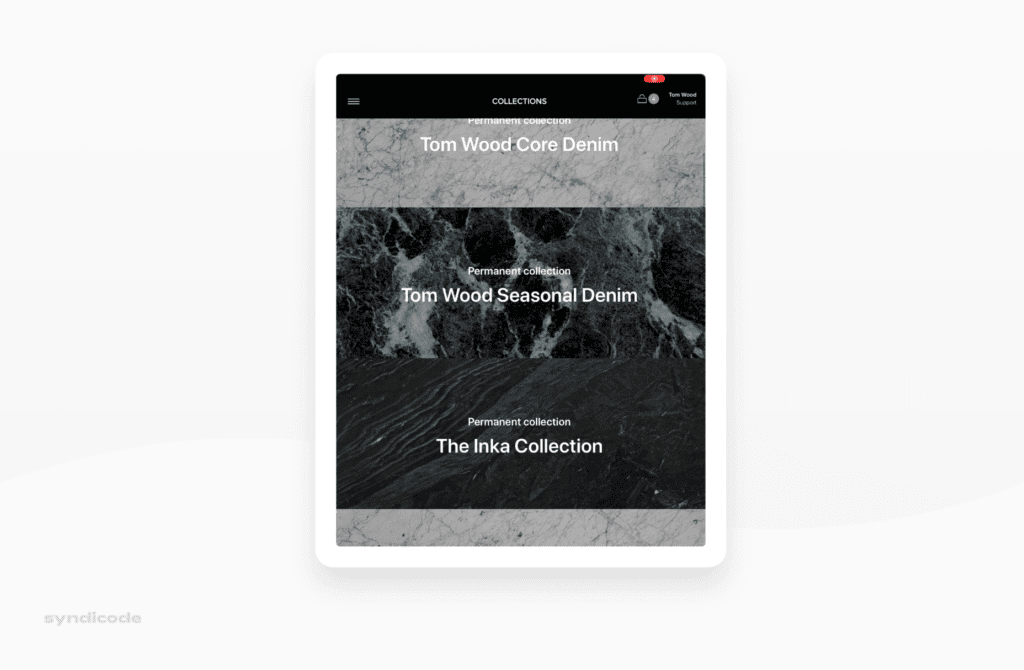
What’s more, we are currently working on an image adjustment tool for iOS that uses neural networks and real-time processing. Our engineers created a solution that detects certain objects on an image, transforms them into a 3D model, and quickly renders it.
A user can amend facial features on a photo simply by moving sliders with the tool. We also implemented an inpainting feature enabling users to remove objects on an image, automatically filling in the empty space with contextually appropriate data.
We customized an AI library to adjust the tool for smooth running on a mobile device. Additionally, we implemented a real-time hair color change functionality. For this, we customized and integrated a 3D API that identifies hair and gently repaints the area.
Unfortunately, we can’t disclose the client’s name due to confidentiality concerns.
What you need to know about application development
According to the definition of a mobile app, its bare functional minimum entails the ability to run on a mobile device (phone, tablet, watch, etc.), presence in the App Store or Google Play, and the use of the native device’s features such as touchscreen, accelerometer, GPS, Bluetooth, etc.
Of course, none of that is enough to compete. Hence the reason companies keep enhancing their apps’ functionality, launch speed, processing speed, etc. That’s why two apps doing the same thing can provide drastically different experiences and vary greatly in cost.
For example, how much does it cost to build an app like Uber or its rising competitor, Gett? Both apps require you to plug in your location, then the system calls for cars and builds a route for a driver toward you and to your destination. In addition, the companies are age-mates, both having launched rides in 2010.
However, Uber managed to run and grow on the $1.6M seed investment they received in their first year. Gett needed around $11M to get started. The reason? Our best guess is the difference in the chosen technology stack, the development team composition, its members’ expertise, rates, the presence of the MVP phase, and more.
Our earlier blog post about on-demand app development describes the factors affecting mobile app development costs in detail.
Simple mobile application development
How much does it cost to build an app with only a few features? A basic mobile application doesn’t require senior-level expertise, mostly uses default UI elements, has trivial graphics, and doesn’t use an internet connection. An online catalog like Avon On or a café menu app are perfect examples.
Being nothing special in terms of design, these apps, nonetheless, let you do many things. At the same time, a simple app doesn’t work with massive amounts of data and can be built using pre-existing libraries, which is a huge relief in terms of the cost to develop an app. Sometimes, an MVP can be equated to a simple application, too.
At Syndicode, the mobile app development cost will start from $45K–50K for a simple MVP mobile app built from scratch. It includes extensive business analysis, design, coding, testing, and delivery to one platform. We also provide post-launch technical support.
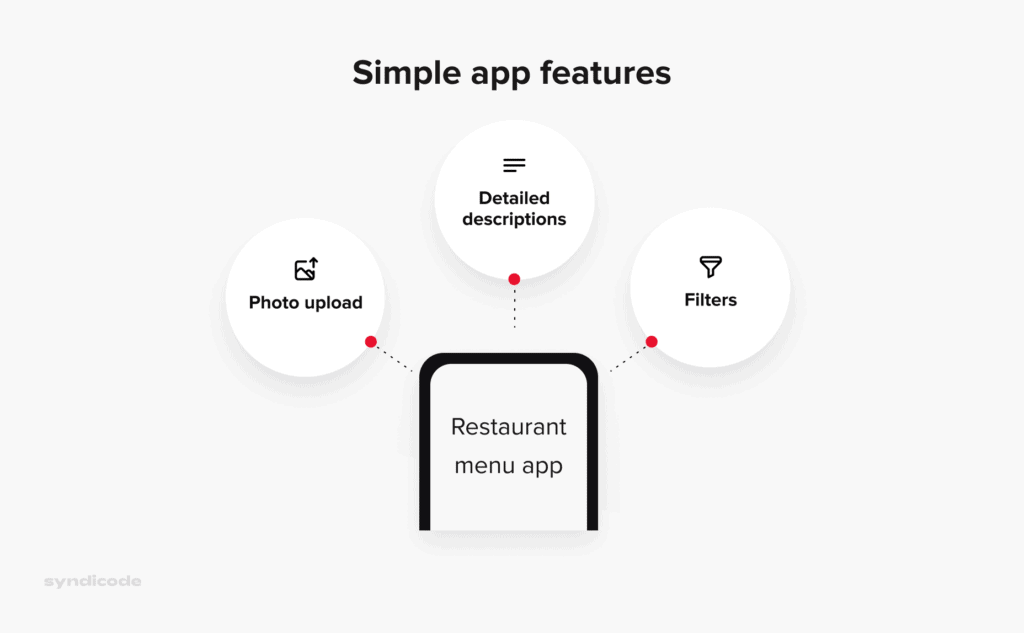
Medium-complexity app development
How to develop an app of medium complexity? While there is no universal definition for a “medium-complexity application,” most sources refer to it as software that can be developed in 5-10 months. An average-complexity app requires a backend with an admin web panel, has some API integrations, and may have a couple of killer features or high-quality animation.
How much does it cost to build such an app? Well, the list of features can be expanded, and they can be infinitely enhanced in terms of design and functionality. At Syndicode, the mobile app development cost for one of medium-complexity made from scratch is around $80K–120K or more.
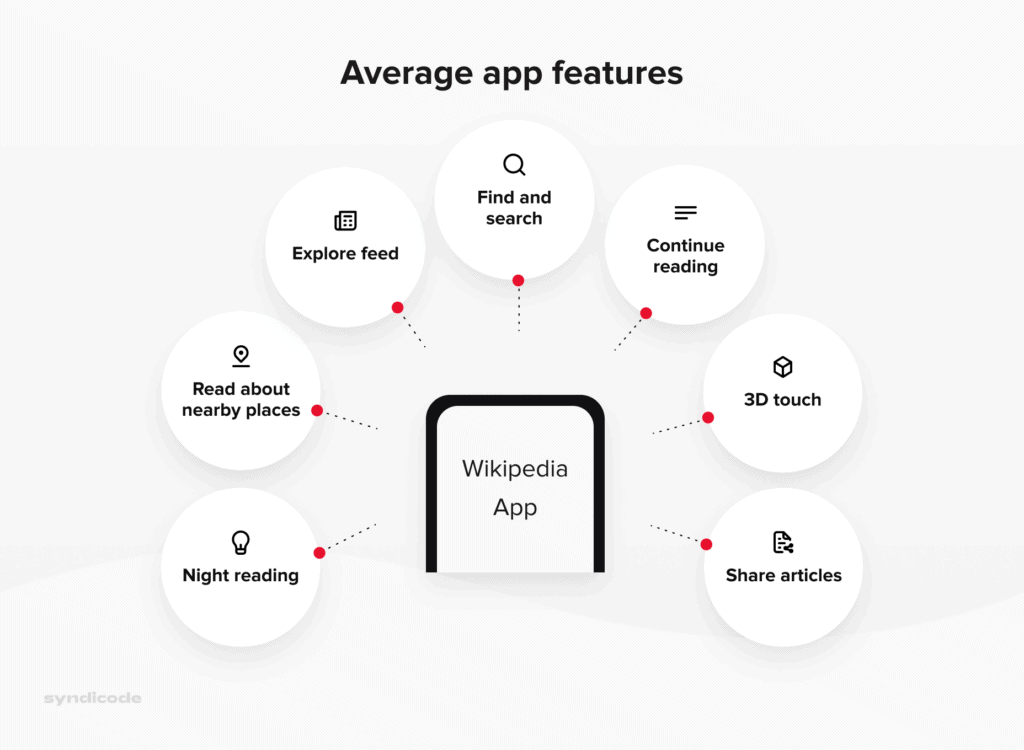
Advanced application development
Advanced applications are usually completely custom-built native solutions or enterprise apps with various features. The use of AI, image recognition, the ability to quickly process terabytes of data, and custom CRM systems are all advanced features that require highly qualified teams to work on them.
At Syndicode, we are continuously expanding our knowledge of the latest technologies and adopting the best practices. To apply the most beneficial technology for a project, we start our work with an extensive analysis of your business, niche, requirements, and risks. QA is an integral part of the development process in our company, but we tend to start it earlier for large projects due to the higher risk of missing a defect.
How much does it cost to build a complex app? The app development price for a custom complex solution starts at $150K and goes up. To decrease time-to-market, we approach complex app development iteratively. Thus, the first version of an app will only have the crucial features, the list of which will grow with the release of each following version.
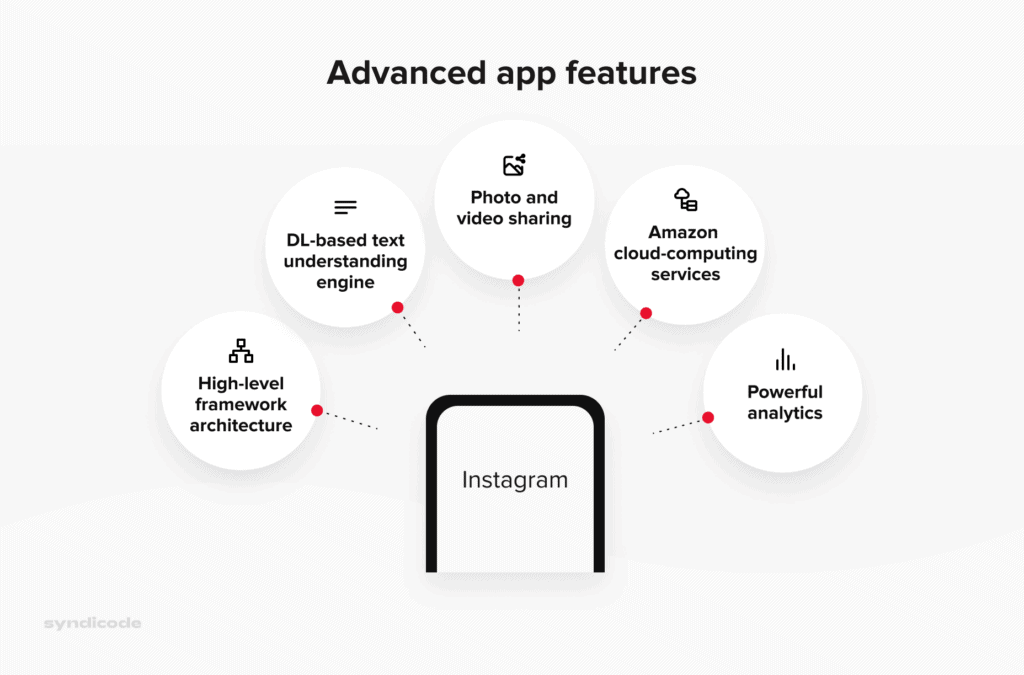
Have an idea?
Share your vision with us. Our experts have a bunch of thoughts on efficient implementation to offer.
Contact usFactors affecting app development cost
Apart from software complexity, other factors can increase or decrease the cost of mobile application development. For instance, you may use internal or external resources for development or mix the two. Depending on your internal IT team’s expertise, a certain proportion of external knowledge engagement will be the most beneficial.
Next, native app development costs differ for each platform. However, the average cost of app development will be lower than a cross-platform solution for some platforms.
The presence of custom APIs requires extra effort to be put into the development, hence higher costs. At the same time, off-the-shelf solutions may dramatically increase the cost of app maintenance if they are not ready to perform the required task.
Among other factors, there are:
- Your niche
- Developers’ location
- Third-party integrations
- Animations
- Localization
- UI/UX requirements
Let’s discuss some of them in more detail.
Engagement model
An engagement model specifies how specialists engage in the project, their responsibility level, payment terms, management, timelines, how they develop an app, etc. Depending on your project’s planned duration, technical expertise, research depth, and level of detail, some engagement models will be more efficient than others.
In-house team
How much does it cost to build an app with an in-house team? Hiring employees to work on your premises is justified, whereas there is a constant flow of tasks for a lengthy duration. With an in-house team, you build a strong foundation for tackling a certain type of task that certainly pays off over a long period. At the same time, you should provide them with regular payments whether they worked on your project or did something else.
Fixed-price model
Outsourcing is more appropriate for irregular workflow or a one-time project, as you don’t have to spend resources on hiring and termination employees. Also, using a fixed-price model, you can freeze your mobile app development cost and timeline before the development starts. By doing so, you can substantially reduce the risk of going over budget, but only if you have a thorough development plan.
Time and materials model
Non-fixed price or time and materials (T&M) model works well when the project scope is unclear. For instance, when you have to develop software under dynamic market conditions or when the involved technology evolves rapidly. Using this model, you only pay for the time spent on your project and not for administrative tasks, training, or bench time.
Dedicated team
A dedicated team and outsourcing models also let you control the development costs by scaling your team up or down, depending on how much is on your plate. Compared with the T&M model, you have more control over the mobile app development cost and process. You can assign roles, allocate workload, set new requirements, etc.
Region
Have you ever wondered how much it costs to build such an app overseas? Indeed, the app programmer’s cost generally reflects the average cost of living in their area. Developing countries have relatively low taxes that do not exceed the 30% personal income tax rate. For comparison, tax levels reach up to 50% in Western European countries and the USA.
Therefore, the less one has to spend to live, the lower the wage they tend to demand. Below is a table comparing the average per hour rates of mobile software developers in different countries. Using it, you can calculate your project’s approximate app development price. We used Clutch for reference.
| Region | iOS | Android | Cross-platform |
|---|---|---|---|
| USA | $150 | $190 | $225 |
| UK | $125 | $150 | $190 |
| Western Europe | $100 | $130 | $150 |
| Central Europe | $75 | $100 | $110 |
| Eastern Europe | $50 | $60 | $70 |
US developers tend to charge at least two times higher rates than their European counterparts. At the same time, Eastern European developers deliver excellent IT services, have a convenient time difference, and share enough cultural similarities to ensure comfortable communication. English proficiency level here is high, too, with about 70% of the population being fluent speakers.
Syndicode takes advantage of remote hiring and picks the top talent from the Eastern European pool. Our developers have solid hard and soft skills, creatively approach tasks, and easily adapt to different environments when outsourced. At the same time, our typical app development cost rates are at the lower end.
Industry
Your business’s industry may dictate certain requirements for the software to be competitive, which affects mobile app development costs. For example, many medical apps incorporate a costly electronic health record to store and manage patients’ medical data.
Financial applications have multiple payment gateways to offer users their favorite method and improve UX. Most payment gateway providers charge monthly fees, and some integrations may need an extra effort for an extra cost.
E-learning apps have to provide a high level of personalization and many expensive animations. Mobile games are another booming market that requires professional planning, high-level UI/UX design, and advanced graphics—each at an extra cost.
Below, you can see an estimated answer to how much it costs to build an app in different industries. While the apps listed as examples cannot be replicated, we took their main features and created a rough pricing model. Our calculations are based on the assumption that third-party integrations do not need any extra work, and a standard team of 4 units is engaged in the project.
| App type | Development cost | Timeline | Example |
|---|---|---|---|
| Marketplace app | $150K–$300K | 15+ months | Amazon |
| Logistics app | $80K–$280K | 8+ months | Scandit |
| Healthcare app | $75K–$250K | 8+ months | Teladoc |
| Finance app | $140K–$230K | 15+ months | Mint |
| Entertainment app | $100K–$150K | 10+ months | Angry Birds |
| Education app | $98K–$160K | 10+ months | DuoLingo |
| Hospitality app | $95K–$280K | 9+ months | Airbnb |
| E-commerce app | $120K–$290K | 12+ months | eBay |
Platform
The way you develop an app also affects the overall app development cost. Thus, a solution for Android generally takes longer than for iOS because the platform requires writing more lines of code.
Moreover, if you build an app for a less popular platform like Windows Phone, your development team might need some time to master the necessary tools. And that naturally elongates the timeline, thus increasing costs.
Now, let’s discuss how much it costs to build an app for popular operating systems in more detail.
iOS app development cost
Apple’s audience is tech-savvy and demonstrates high UI/UX design expectations. At the same time, App Store security and performance requirements pose additional challenges other platforms do not.
To create a profitable iOS application and minimize the risk of it being rejected by the App Store, thorough software testing is a must. Its price is about 10-20% of the total app development price. At Syndicode, we minimize QA expenses by applying best-performing QA practices. Every line of code is checked for compliance with acceptance criteria to ensure the apps’ stability.
Android app development cost
The answer to how much it costs to build an app for Android lies in the platform’s specifics. Android’s architecture requires writing more lines of code to get a certain functionality compared to iOS development.
Also, there are about 1,300 Android device manufacturers, each modifying different software parts to suit their needs. As a result, developers have to deal with a wide variety of vendor-specific cases. Android app design also tends to take more time due to various screen sizes and resolutions. Finally, more QA work is needed to cover a wide device set.
Cross-platform development cost
Developing apps to perform across different OS equally is a lengthy process that requires advanced technical knowledge. Since each platform requires unique code, codebase management becomes tricky.
Also, the technology for building cross-platform solutions evolves quickly. So, to keep up with the advances, your team might have to change the development tool in the middle of the project. The search and mastering of the newest tech may take time which inevitably increases the price.
Finally, cross-platform solutions are cumbersome to update to the current OS version since iOS and Android do not synchronize their releases. This results in cross-platform solutions costing around 1.5 times more than native development for one platform.
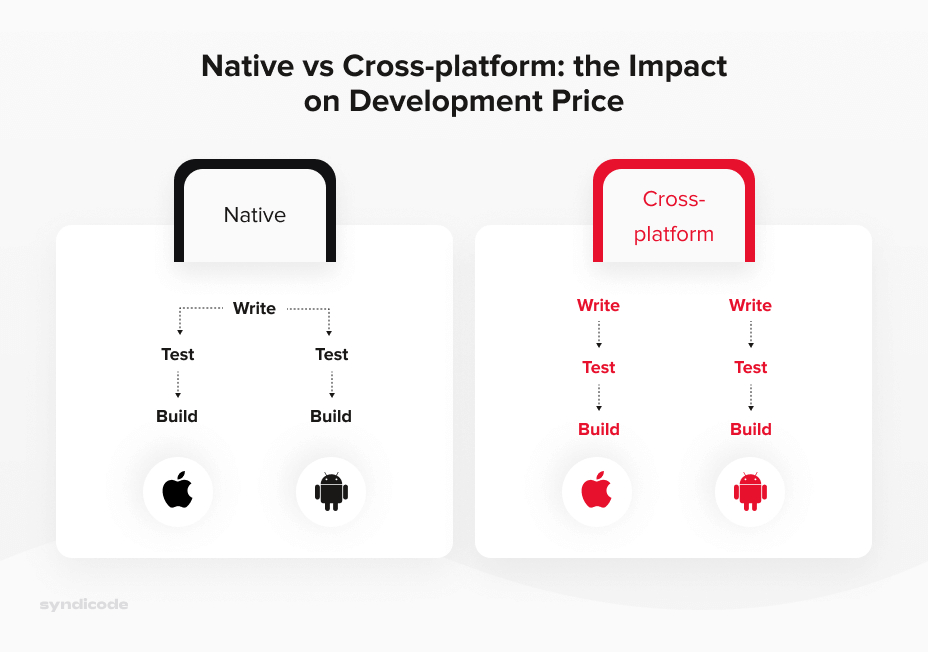
Want to build a custom app?
We develop custom solutions of any complexity from scratch. Check out the dedicated page.
See servicesFeatures
We’ve already talked about the price of simple and complex apps, but how much does it cost to build an app with a certain feature? Features are the main area of concern when determining the application complexity. Their number and technical implementation may vary depending on your idea, thus affecting the final development price.
An app’s complexity also depends on the cohesion of its features. Thus, if a group of features isn’t logically compatible, they need to be placed on different screens. There is more work for a designer and a mobile architect with each new screen, which is reflected in the pricing.
But how can the same feature cost a different amount? In most cases, a feature can be built, either in its basic implementation or in a more advanced variant.
For example, a sign-up/login feature can be represented by sign-up and login functionality using a standard email and password pair. It also should provide the ability to restore a lost password and have an admin page where support staff can delete inactive users and reset passwords. This functionality is usually enough for an MVP or a really basic application.
In this case, the implementation will take approximately 6 hours for UI/UX design, 18 hours for backend and mobile, 4 hours of work to add the functionality to the support web app, and 8 hours for quality assurance. In total, that’s 36 hours for an MVP-worth implementation.
Now, imagine you’re building an enterprise solution. In addition to the basic implementation of the sign-up/login feature, you will need a complex branded design, the ability to sign up/login using a mobile phone, support for multi-device login, quick login using third-party platforms, and two-factor authentication.
The feature still does nothing beyond letting users sign up or log into the app. However, the second implementation variant involves much more work and will take at least 5 times as much as the basic implementation.
Some advanced features require a proof of concept (PoC) before being implemented. PoC is a demonstration of feature feasibility, an intermediate result of the Research & Development (RnD) process that aims to find the most efficient technology and a way to build a non-standard functionality.
A good example is an ID card recognition module that can be implemented in many ways, unique for each project. To find the most fitting solution, we suggest an RnD phase and create a PoC. If the client approves our vision of how the feature should be implemented, we proceed with its development.
In the table below, we outline some features of a mobile application and the estimated time and cost ranges depending on the chosen complexity.
Basic features of a mobile application
| Feature | Description | Time, hrs | Price (rate $50/h) |
|---|---|---|---|
| Call a phone number | 1) The user can call a seller’s phone number by tapping on it 2) App highlights numbers in the text, providing the ability to tap and call | 1) 25–30 2) 50–75 | 1) $1,250–$1,500 2) $2,500–$3,750 |
| Start an email | The app can start a new email with the user’s email account on the mobile device | 25–30 | $1,250–$1,500 |
| Open a webpage | 1) The app can open a page in a browser to present the user with more detailed information 2) The app can open a page in an in-app window and control its behavior | 1) 25–30 2) 90–100 | 1) $1,250–$5,000 2) $4,500–$1,800 |
| List of entities | 1) Once the entities are in the app, the user can review them in a read-only mode 2) The user can review, add, and remove entities | 1) 75–90 2) 100–125 | 1) $3,750–$4,500 2) $5,000–$6,250 |
| Basic search | 1) The user can perform non-live searches by 3 criteria 2) Live search by many criteria with more results loading on a scroll | 1) 100–115 2) 200–300 | 1) $5,000–$5,750 2) $10,000–$15,000 |
Average app features
| Feature | Description | Time, hrs | Price (rate $50/h) |
|---|---|---|---|
| Account management | 1) The user can purchase directly from the app, choosing from several payment methods, and can restore their purchases 2) The app provides server-side consumable purchases, or is subscription-based | 1) 125–150 2) 300–400 | 1) $6,250–$7,500 2) $15,000–$20,000 |
| In-app purchases | 1) The user can purchase directly from the app, choosing from several payment methods, and can restore their purchases 2) The app provides server-side consumable purchases or is subscription-based | 1) 175–200 2) 525–625 | 1) $8,750–$10,000 2) $26,250–$31,250 |
| Attaching a gesture to an action | 1) The user can navigate the app with a swipe gesture 2) The user can move/scale/rotate an image with pan/pinch gestures | 1) 75–90 2) 100–150 | 1) $3,750–$4,500 2) $5,000–$7,500 |
| Analytics | 1) Firebase crashlytics integration 2) Sellers and app owners can review the most popular items and how the application is being used | 1) 65–75 2) 300–375 | 1) $3,250–$3,750 2) $15,000–$18,750 |
| Location service | 1) The user can search for nearby entities 2) The app also performs background route tracking (RnD may be required) | 1) 100–125 2) 200–250 | 1) $8,750–$10,000 2) $10,000–$12,500 |
Advanced application features
| Feature | Description | Time, hrs | Price (rate $50/h) |
|---|---|---|---|
| Offline data support | 1) Application stores trivial data like user profiles and allows to review it in offline mode 2) Users can edit information when offline | 1) 100–125 2) 600–750 | 1) $5,000–$6,250 2) $30,000–$37,500 |
| Personalized product recommendations | 1) The app picks similar products using a simple algorithm 2) The app can dynamically present products to a user depending on their history and browsing behavior | 1) 100–125 2) 350–400 | 1) $5,000–$6,250 2) $17,500–$20,000 |
| Face detection on photo | 1) The app highlights faces on a photo 2) The user can apply some effect to faces on the photo (effects are implemented separately) | 1) 100–125 2) 150–200 | 1) $5,000–$6,250 2) $7,500–$10,000 |
| Text recognition | 1) The app can detect phone numbers on an image 2) The app can recognize a particular document type | 1) 100–125 2) 400–500 | 1) $5,000–$6,250 2) $20,000–$25,000 |
Besides the features, app development includes quality assurance and management activities. Thus, the total estimated cost of a mobile app with the features listed in the table above is as follows:
| SDLC stage | Time (basic app) | Estimated cost (basic app) | Time (advanced app) | Estimated cost (advanced app) |
|---|---|---|---|---|
| Development | 865–1,010 hrs | $43,250–$50,500 | 1,265–1,510 hrs | $63,250–$169,500 |
| QA | 87–101 hrs | $4,325–$5,050 | 127–151 hrs | $6,325–$21,400 |
| Project management | 130–152 hrs | $6,488–$7,575 | 190–227 hrs | $9,488–$32,100 |
| Total | 1,082–1,263 hrs | $54,063–$63,125 | 1,581–5,350 hrs | $79,063–$267,500 |
Obviously, the list of features is not complete, and it’s impossible to cover everything an app can possibly do. Please note that the time and prices listed in the table are for reference only. We recommend that you consult with your tech partner to find out how to develop an app according to your needs and get individual estimates.
Syndicode mobile app development process
We follow an Agile development methodology, working in iterations and developing mini-increments of the new functionality at each cycle. This minimizes risk when adding new functionality and speeds up the overall development process.
At Syndicode, the development process is divided into several phases, with specified deliverables at the end of each. We follow these steps to ensure the developed application’s highest quality and the lowest possible cost.
Step 1. Discovery
We start a new project with a kickoff meeting to note the client’s vision, identify problems, and register stakeholders. Then, we model a concept and analyze business objectives and risks.
At the end of the discovery phase, we have the scope of work, entities and their roles, and functional decomposition of the system. All that allows us to better understand the essence of the problem we are trying to solve and the existing limitations. After this step, we’re ready to make time and app development cost estimates and clearly answer how much it costs to build an app for you.
Step 2. Design
The next step of the mobile application development process is market research and understanding of the long-term business objectives. Then we narrow down the vision by identifying use cases. Next, we create a generalized project structure. Based on that, Syndicode designers create a visual design.
Sometimes, interactive wireframes are created based on the project structure diagram. They are necessary for intermediate concept testing on a focus user group and idea validation. Finally, the mockups and design libraries go to developers to be turned into code.
Step 3. Development
Syndicode developers build a working application based on design specifications, development plans, and standards. Our project managers ensure developers’ proper understanding of the tasks and project objectives and effective communication of the team involved and stakeholders.
Our team also develops an organized document repository that helps code understanding and is used for testing. Our developers have mastered various tools and programming languages to choose the most appropriate stack for your project. Among the most used are Ruby on Rails and React.
Step 4. Testing
We perform testing as soon as a system unit is complete. Still, our testers make an additional effort to check the completed product for bugs and other defects. They go over the application to check its structure and functionality for adherence to the standard previously defined by the Software Requirements Specification (SRS) document.
At this stage, you may want to inquire again about how much it costs to build your app. If you outsource a dedicated team, the price may change depending on how early QA was introduced in the project.
Step 5. Maintenance
As soon as the application is in full operation, you can request maintenance from the Syndicode team. Each month, we devote an agreed-upon number of hours to perform app upgrading, repairs, fixes, and bug elimination.
Syndicode engineers will help you keep your application up to the current market requirements, including new policies and client demand for certain features or functions. We improve software adaptability to new OS versions and hardware advances. Additionally, we can help you pivot your application in case of any organizational changes.
Your app lacks features?
We will expand your app functionality, leaving the initial structure intact.
Contact usHow to decrease the app development price
Highly competitive markets challenge businesses to develop visually attractive applications that bring real value, are simple and quick to use, perform various functions, and do not take years to make. Does it sound expensive to you?
Moreover, as you ask, “how much does it cost to build an app?” at the beginning of the project, you get only an estimate. The final value may be quite different from what you expected since it’s impossible to predict all the possible market fluctuations.
At Syndicode, experienced analysts do careful market research and work together with project managers to minimize budget variances. As a result, the majority of our project budget variances do not exceed 10%.
Still, you can follow the steps below and help to minimize the application development cost even more.
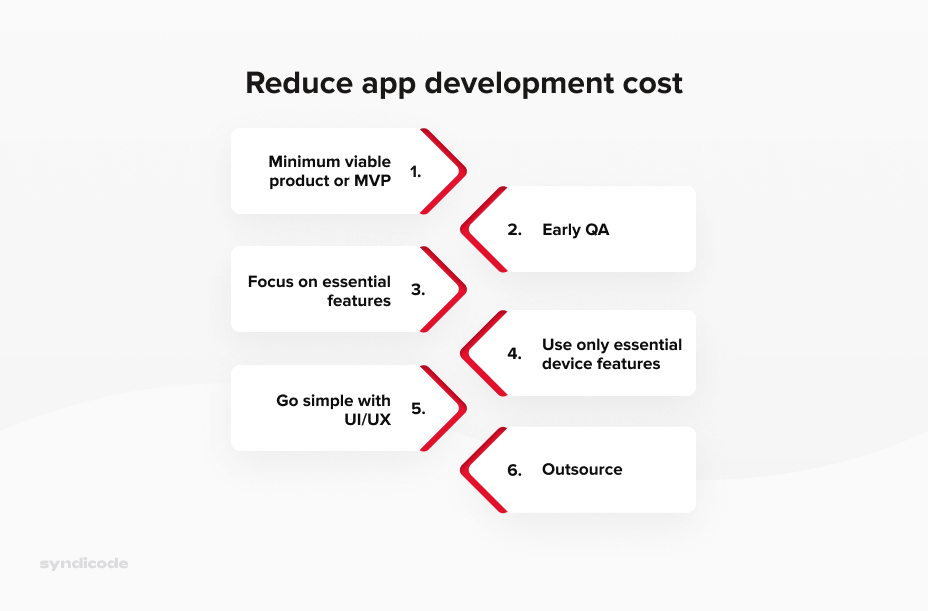
1. Research
You can rely on Syndicode to study the market, identify the best practices, assess risks, and offer a plan for how to develop an app for you with minimal participation from your side. However, you may skimp by doing all this on your own.
Start by defining the target audience for your application, their habits, needs, and routines. Then, explore similar solutions that exist in the market, focusing on their strengths and weaknesses. Brainstorm ideas on what kind of a solution could outperform the competition. Try to be as specific as possible so that your development team won’t waste time asking for clarifications.
2. Hire a QA team
Yes, we already explained that testing generally increases the development cost by 15-20%. However, an unnoticed error can cause serious problems leading to significant financial losses to cover the damaged reputation.
In 2020, the USA’s cost for poor software quality totaled $2.08 trillion. At Syndicode, we noticed that the cost of fixing an error grows exponentially toward the end of the SDLC. So, the earlier you start testing, the fewer resources you’ll spend in the long run to eliminate a bug.
3. Opt for full-cycle development
Having the same team work on your project from start to finish eliminates the communication and coordination problems. If your team members know each other at the start of the project, they will quickly establish routines, assign roles, and get to work without taking extra time to get acquainted. Additionally, since they know each other’s strengths and weaknesses, the chance of delays is lower, thus minimizing app development costs.
Putting it all together
So, how much does it cost to build an app, and what can you expect as you plan a budget for custom application development? According to top software development companies found on Google and our own expertise, the price of mobile app building falls between $50K–$500K.
The total app development cost for a custom solution consists of the sum of features implementation prices, quality assurance cost, and management activities cost. While the price of QA and management is more or less stable, representing a percentage of the total development cost, features are a variable component.
Also, the target platform, the chosen engagement model, and your development team members’ rates can increase or decrease the price of development. You can regulate costs by limiting the number of features and third-party integrations, hiring from offshore countries, and partnering with an experienced full-cycle development company.
Frequently Asked Questions
-
Why should I launch a mobile app?
There are over 6.3 billion smartphone users in the world, and the majority of them prefer mobile apps to websites. Among the main reasons are better personalization, the simplicity of notification sending, the advantage of accessing mobile device features, the ability to work offline, better performance, and fewer restrictions in terms of design. In addition, 80% of the US population shop online, making mobile applications a must for online retailers. But even if you aren’t in the retail industry, a mobile app is a powerful marketing source, presenting your brand before the customer’s eyes every time they look at their smartphone. What’s more, whatever number you get on how much it costs to build an app, in-app ads are quite lucrative.
-
How long does it take to develop an application?
Just like with “How much does it cost to build your app?”, there isn’t one answer to this question as mobile applications vary in complexity. Also, the development timeline will be different with a freelancer and an entire team working on your app. Still, in our experience, smaller apps that can access device features, use an internet connection to upload data, allow profile creation, and some basic actions such as likes and comments usually take up to 8–12 months. Bigger applications aimed to automate business processes, have complex logic, or use advanced technologies such as neural networks may take a year or more. After a discussion with your tech partner, you will get a more precise estimate of your app development cost.
-
How to choose the right app development company?
The notion of the “right” technical partner differs depending on your business type, goals, location, budget, the price of mobile app development you expect, and personal preferences. Generally, we recommend looking for a software development company that has experience in launching projects similar to yours. An experienced partner will be able to answer how much is to develop an app and keep up to their promises. Thus, the Syndicode team has substantial experience in marketplace building of any complexity from scratch. We designed and created highly customizable solutions for a wide target audience and various features. Our marketplaces process massive amounts of data and scale easily. We also know how to develop an app with image processing functionality, neural networks, custom API, and microservices.
-
How much does app maintenance cost?
Usually, a full-cycle web development partner provides a cost estimate with maintenance included right after you ask, “how much does it cost to build an app?” Some companies, though, do not give any answer on how much does it cost to make an app for your business. Instead, they offer you buy maintenance services after the app release to update the app’s content, adhere to policies, improve performance based on user feedback, address any malfunctions, etc. Maintenance costs vary among different software service providers. At Syndicode, we assign a support technician to provide on-demand support for 30 days after application release. After this term, you can purchase our maintenance package which includes at least 80 hours of work per a specified period. Thus, the cost of application maintenance starts from $4,000 per month. Also, some sources found online suggest budgeting around 20% of your total app development cost for maintenance.
-
Which application development do successful businesses choose: native or hybrid?
A native application is developed using the corresponding operating system’s SDK and has access to all of the device’s features, such as camera, microphone, Bluetooth, and others. Native apps are easy to customize and generally provide better UX than other application types. How much does it cost to build an app that is native? First, it’s worth noting that a custom native app has to be built from scratch. Also, each OS requires knowledge of different frameworks and languages, which makes native development costlier compared to a hybrid app. A hybrid app is basically an HTML structure wrapped into a native shell. So, its development usually costs less compared to building a native app. However, it has limited access to the device’s features. Moreover, any effort to customize a hybrid app will require a lot more work than with a native solution. So, if you are looking for a high level of customization, you might find out that a hybrid app development cost is actually higher than that of a native app.
